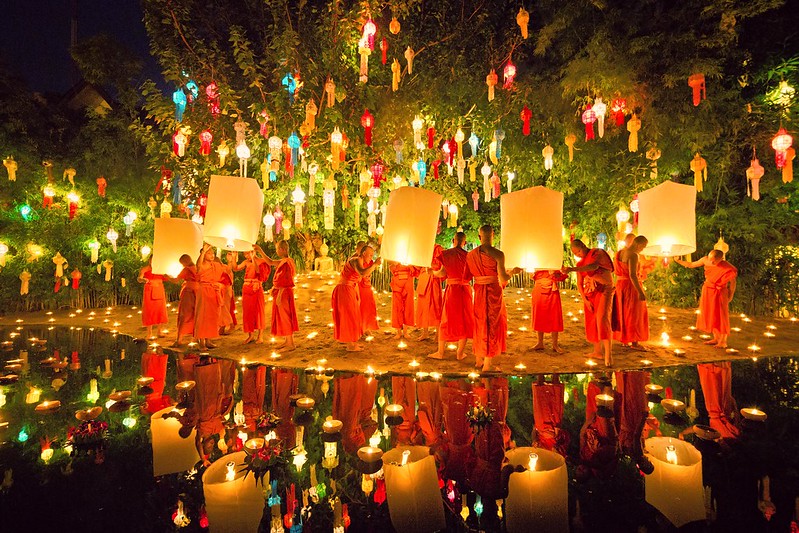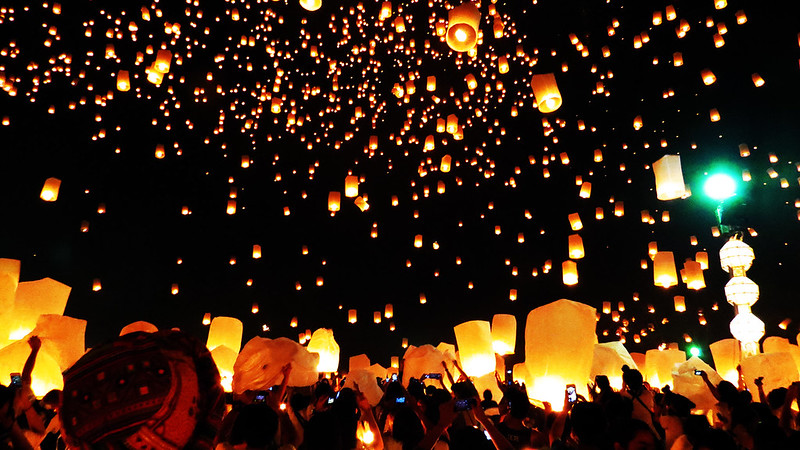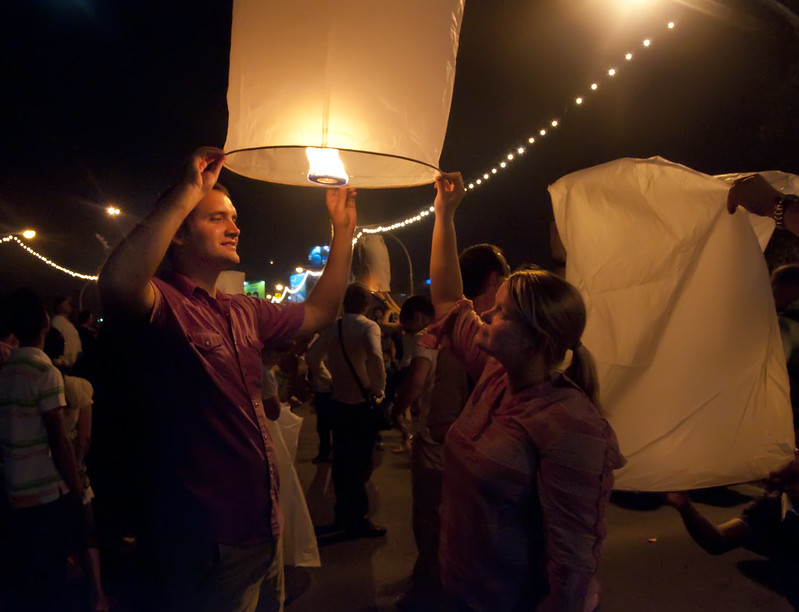Yi Peng and Loi Krathong
Lanterns of Hope: The Twin Festivals That Illuminate Chiang Mai’s Night Sky
2026/11/23 - 2026/11/24
In November, when the full moon rises over Chiang Mai, the city transforms into a fantastical world of shimmering rivers and glowing skies. Yi Peng and Loi Krathong—two festivals where light, water, and wishes intertwine—draw tens of thousands of people together. The city’s ancient walls, lively bridges, and tranquil temples become the stage for a celebration that stimulates the senses and leaves a deep impression on all who visit.
Whether you’re a traveler seeking breathtaking views, a photographer, or a local cherishing tradition, Yi Peng and Loi Krathong captivate everyone. Held annually from mid to late November, centered in Chiang Mai, these luminous festivals attract people from all over Thailand and the world.
Main Attractions
Mass Release of Khom Loi (Sky Lanterns)
The greatest highlight of Yi Peng is the moment when thousands of khom loi (sky lanterns made of paper) are released into the night sky all at once. As dusk falls, people gather at places like Nawarat Bridge and Mae Jo, lighting lanterns with their wishes. The golden lights soar into the sky, creating a breathtaking scene—countless lanterns fill the sky, illuminating people’s faces as awe and joy quietly spread through the crowd.
Floating Krathongs on the Ping River
While the sky shines above, the water’s surface below is also adorned with magical lights. Krathongs—lotus-shaped floats made from banana leaves and decorated with candles and flowers—are gently set afloat on the river. The scent of candles, jasmine, and incense drifts on the night breeze, and the river reflects countless flickering lights. This ritual, meant to wash away misfortune and invite good luck, brings a quiet sense of wonder.
Candlelight Ceremonies at Temples
At temples such as Wat Phan Tao, hundreds of candles illuminate the grounds while monks’ chanting echoes softly. The warm glow of candles, the gentle sound of monks’ robes, and the scent of sandalwood create a calming atmosphere, allowing visitors to experience the essence of the festival.
Parades and Traditional Performances
Throughout the city, parades feature dancers and musicians in traditional attire, accompanied by the beat of drums, laughter, and occasional fireworks. Beauty pageants and lantern-making contests add to the festive mood, and the aroma of grilled foods and sweet treats from street stalls tempts the appetite.
Costumes and Decorations
Yi Peng and Loi Krathong are visually stunning festivals. Women wear handwoven sinh (skirts) and silk blouses, while men don indigo-dyed shirts and sashes—traditional Lanna attire. Children dress up in miniature versions with hair ornaments and face paint. Houses, temples, bridges, and gates are decorated with colorful lanterns and lights. Lanterns in the shapes of stars, birds, and mythical creatures sway in the night breeze, casting fantastical shadows.
Traditional Food and Drink
The festivals are also a delight for the taste buds. Street stalls offer sai ua (Northern Thai sausage), khao soi (curried noodles), grilled chicken, and more, filling the air with savory aromas. Sweets like coconut sticky rice and mango sticky rice are also popular. For the adventurous, crispy fried insects are a local treat! Herbal teas and sugarcane juice quench your thirst, and sticky rice sweets wrapped in banana leaves provide a comforting finish.
Cultural and Historical Background
The origins of the festivals blend both Buddhist and Hindu beliefs, centered on faith in water, light, and renewal. Yi Peng began in the ancient Lanna Kingdom as a merit-making ritual for Buddha, with sky lanterns released to dispel misfortune and send wishes to the heavens. Loi Krathong, originally a Hindu ritual, evolved into a Thai Buddhist festival to honor the water goddess Mae Khongkha and show gratitude for the river’s blessings. In Chiang Mai, the two festivals have merged into a unique celebration where water, sky, tradition, and community come together.
For locals, these festivals are not just events—they are important times for spiritual cleansing, gratitude, and strengthening family and community bonds. Releasing lanterns and krathongs is a prayer to let go of past worries and hope for new fortune. Making krathongs and sharing meals with family and friends is also an opportunity to pass traditions to the next generation.
Participant Voices
I came to Chiang Mai from Germany. I fell in love with the lantern photos I saw online, but being there in person was beyond anything I imagined. Lighting lanterns side by side with locals and tourists, then releasing them into the sky together, everyone silently watching—it was magical. Later, as I watched families floating krathongs by the river, a local woman taught me how to fold banana leaves and told me she writes her wishes on paper and puts them inside. I felt a mysterious sense of belonging, as if I had always been part of this place.
Fun Facts
- During the peak of Yi Peng in Chiang Mai, over 100,000 lanterns are released into the sky, making it one of the world’s largest lantern events.
- Traditional krathongs are made from banana trunks and leaves, but recently, eco-friendly krathongs made from bread or biodegradable materials have become popular to protect the river.
- The “Miss & Mister Yi Peng” contest is also held in Chiang Mai, with children competing in traditional costumes, making it a source of local pride.
- Locals sometimes put nail or hair clippings in their krathongs as a symbolic way to let go of past worries and misfortune.
Festival Dates
The event schedule is subject to change. Please check the official website for the most up-to-date information.
Information
| Name | Yi Peng and Loi Krathong |
| Country | Thailand |
| Area | Chiang Mai |
| Date | 2026/11/23 - 2026/11/24 |
| Link |
Upcoming Festivals
Whirling Dervishes Festival Turkey
A Mesmerizing Dance of Divine Love
2025/12/06Mevlana Celaleddin Rumi Commemoration Ceremony ( Şeb-i Arus ) Turkey
A Whirling Journey to Divine Love
2025/12/10Dia de la Virgen de Guadalupe Mexico
A Festival Weaving Faith, Fervor, and Mexican Identity
2025/12/11L'Escalade Switzerland
Geneva’s Grand Winter Festival of Courage, Chocolate, and Community
2025/12/12Umkhosi Wokweshwama South Africa
The Zulu First Fruits Festival—A Sacred Celebration of Land, Ancestors, and Renewal
2025/12/12Lucia Festival (St. Lucia's Day) Sweden
A Festival of Light Illuminating the Nordic Darkness
2025/12/15Las Posadas Mexico
The Luminous Quest for Sacred Shelter
2025/12/22Noche de Rabanos (Night of the Radishes) Mexico
A celebration blending art, farming heritage, and cultural traditions
2025/12/23Chant of the Sybil on Majorca Spain
A Medieval Prophecy Echoes Through Majorcan Christmas
2025/12/23‘Hatajo de Negritos’ and the ‘Hatajo de Pallitas’ Peru
A Christmas Festival of Rhythm, Faith, and Afro-Andean Heritage in Peru’s Ica Region


